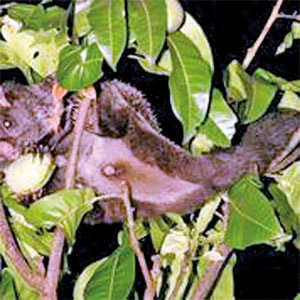A ‘must’ addition in the field bag for keen naturalists
View(s):This new book on the mammals of Sri Lanka is the first portable and affordable photographic field guide with near comprehensive coverage with 96 per cent of all the land and marine mammals recorded in Sri Lanka. ‘A Naturalist’s Guide to the Mammals of Sri Lanka’ covers 122 of the 127 land and marine mammals recorded in Sri Lanka.

Giant grey flying squirrel. Pic by Gehan de Silva Wijeyeratne
Published by John Beaufoy Publishing, it is the seventh Sri Lankan title by this British publisher who has a long association with Sri Lanka and other countries in the Asian region. The lightweight book with a page length of 176 pages follows the standard format for the Naturalist’s Guide series and is in a pocket-sized shape of 130 mm wide and 180 mm high. The size and shape enable the book to be a permanent addition in the ‘field bag’ for keen naturalists. The book uses multiple images with identification focused text to provide a compact field guide which will be useful for resident naturalists and visitors.
The author and principal photographer of the book is well-known natural history populariser Gehan de Silva Wijeyeratne who has over 20 books and 380 articles published.
Sri Lanka has a good mammalian diversity and the book covers all 36 families found in Sri Lanka. As is the case in many parts of the world, many of the mammals are shy small mammals, or are nocturnal, or both. As a result the book uses many images taken by full-time researchers who have taken images under capture and release methods under research permits. The author draws attention to the fact that this book was a collective effort drawing upon the contributions of forty-one photographers from nine countries resulting in over 250 images being used.
According to Gavin Thomas, author of the Rough Guide to Sri Lanka, “Interestingly, leaving aside foreign visitors, a lot of Sri Lankans will be surprised at the range of mammals to be found in Sri Lanka. In this book readers will find 33 species of bats, golden palm civets, chevrotains (also known as mouse-deer but not a deer) that swim under water to escape predators, shrews which look like mice but are not related to mice and rats, and a host of other mammals that even professional tourism guides know little about.”
The front section of the book covers details such as climate and weather, monsoons and topography, key places to visit for watching mammals and other wildlife, classification of mammals, whale watching and topography diagrams for bats and cetaceans. It also includes a photographic checklist of the 22 endemic mammals. The inside cover has a map with the key terrestrial and marine wildlife sites.
The end sections include a checklist of the mammals of Sri Lanka, a bibliography and useful information for visitors, covering topics such as internet resources and a list of wildlife tour operators.
The bulk of the book (pages 16-163) is on the species accounts. Each family is demarcated by a text box that provides a thumbnail summary. Here you learn about the key characters of false vampire bats and discover that the bats found in Sri Lanka are from several families and that gerbils which look like mice are in a different family. All of the marine mammals are grouped together and the different types of whales, baleen and tooth are explained.
“The text is the real deal,” says Gavin Thomas, “written by an author who does a lot of field work and is constantly preoccupied with how to help the reader identify what they see.”
Book facts
A Naturalist’s Guide to the Mammals of Sri Lanka’ by Gehan de Silva Wijeyeratne.
Published by John Beaufoy Publishing, Oxford, UK.


